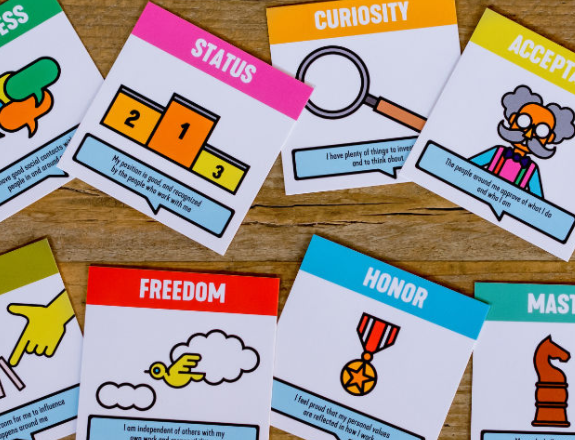
Retros
Goal of a retrospective is to look back on how things (often a sprint) went and define improvement actions. Well organized retrospectives are a great way to energize people and encourage them to improve as a team.
We hold retrospectives because they provide an opportunity for a team to look back and see how they can improve. The teams figures out what the one thing is that can make the team go faster when it is fixed. And then commits to fixing it.
The Retrospective Prime Directive is written by Norman Kerth. It states:
“Regardless of what we discover, we understand and truly believe that everyone did the best job they could, given what they knew at the time, their skills and abilities, the resources available, and the situation at hand.”
This means that we do not blame people in a retrospective. We look at the system and our processes and we try to look for improvements instead.
Read Diana Larsen and Esther Derby’s book Agile Retrospectives – Making Good Teams Great. In the book, they lay out five stages.
- Set the Stage – Understand where everyone is coming from today.
- Gather Data – Get the viewpoints of all members of the team so that you can create a shared picture of what is happening.
- Generate Insights – Unpack the data and analyse or look for the root causes.
- Decide what to do – Make sure the team decides together what is important and what is the most important thing for them to do.
- Close – Appreciate peoples time and get feedback in terms of how to get better at retrospectives, both you as facilitator and the team.
This is an excellent base-line for your retrospectives and makes for a good starting point. Use the book and the stages coupled with your observations to tailor a retrospective for your team. Bearing in mind that sometimes the retro does not need to include the five stages.
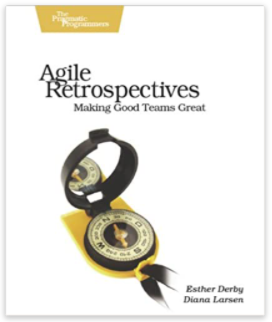
Retromat
The website Retromat.org is an interactive website that has activities for all mentioned phases of a good retrospective. Using the arrows on the website you can compile a retrospective that best suits your needs.
Knowing how to hold a good retrospective is valuable. It is also valuable to be able to recognize behaviour that does not help. Below are some anti-patterns that you need to look our for. And there are retrospetive ideas and formats to keep people engaged.
Retrospective Anti-Patterns to look out for
Here is a list of common anti-patterns of a Retrospective. Try to avoid these situations. And if you find yourself in one of them, try to fix it.
Rushing or cancelling retrospectives
When a team rushes or cancelles retrospectives because of time or other reasons, they miss out on a valuable opportunity to inspect and adapt. Rushed retrospectives may lead to people not seeing the value in a retrospective and ultimately finding it to be waste of time. Do not rush or cancel a retrospective. Use the ideas below to come up with engaging and powerful retrospectives. Because becoming agile is a journey and there is always something to improve.
Extensive complaining
The retrospective is a place where people can get their frustrations off their chest. But after that, they should be able to move on and look for actual meaningful improvements. When people are complaining about outside factors of the team, ask them what they themselves could have done to change the behaviour. This forces people to take responsibility of the problem.
One of our agile coaches, Linda, has started a ’15 minutes of complaints’ at the start of her retrospectives. Team members were allowed to complain for the full 15 minutes. After that, there was no more complaining allowed, only constructive ideas. This has helped her team to break the habit of complaining. This is because after a few retrospectives the team members realised that just complaining is a useless exercise and they stopped doing it.
Meaningless improvements
Improvements should be stated SMART. Specific, Measurable, Achievable, Relevant and Timeboxed. If the team comes up with improvements that are not specific, measurable or achievable, then it is likely nothing will change. The problem still occurs after the next sprint and will likely come up again. If this is repeated multiple times the feeling will creep in that the retrospective is an useless exercise.
No one is responsible for the improvement
So the team has picked an improvement and written it down SMART. But no one is made responisble to actually implement the improvement. It is likely that the improvement will be on the backlog for the duration of the sprint and remain unfinished. Anything on the backlog is a responsibility of the team but it is tempting to work on the items on the items for the product first. After all, that is what the stakeholders are waiting for. A process improvement is not something we do ‘when there is time left’. Make sure someone is responsible for the implementation of the improvement. And talk about it in the Daily Scrum just like any other backlog item.
Another way to help the team is to use the 15% solutions Liberating structure. With this liberating structure you can show the team that there is no reason to wait around for someone outside the team to resolve an impediment. It lets team members look at what is in their own power to start a change. It helps to move away from blockage and negativism, and helps to have people discover their individual and collective power.
Psychological safety
The Scrum Team takes part of the retrospective. The Scrum Team consists of developers, Scrum Master and the Product Owner. They should be able to talk openly about how the past sprint went. Avoid outsiders joining in the event as that would impede people from talking freely. They might be scared for repercussions. Also whatever happens in a retro ‘stays in the retro’. If the discussions leak out of the retrospective, people lose the confidence that the session is private. It is very hard to regain that confidence.
The Starfish retrospective is an easy exercise you can do with your team. It gives you a good overview of the things a Scrum team can change. Draw the star like the picture to the right on a board. The five sections are named start, stop, more, less and keep. Have the team write ideas on post-its and stick them on the board. For each section you can give a short instruction:
Start:What should we start doing to improve our process?
Stop: What should we stop doing that does not bring value?
More: What are we doing well and should we do more?
Less: What are we doing that costs us time and does not deliver as much value?
Keep: What are the things we do well and we should keep doing?
When the board is full of ideas take some time to read and discuss. You can use dot-voting to have the team choose the item they think is most valuable to tackle next sprint. When one or more items are chosen make sure you write the improvement SMART and make someone accountable for its implementation.
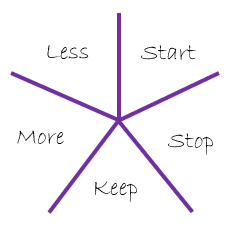
Fun Retrospectives
The fun retrospectives site is a nice one to have in your favorites folder. It contains a lot of ideas to spice up your retrospectives. Next to that it also contains a free online retrospective board. This board is especially useful for distributed teams, since it gives you the online possibility to create notes on a personalized Kanban like board.
The Team Barometer is a self-evaluation tool that allows teams to discover if they get better as a team.
It is run as a one hour workshop. Teams vote on statements on a card. You can download the cards from the page linked above. You can discuss the cards afterwards and calculate a team barometer value. You could run this barometer workshop again after a few months to see if you improved.
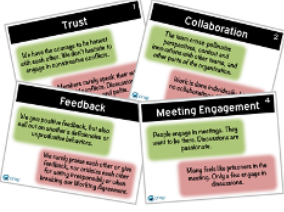
360 Feedback
A 360-feedback session can be very powerful in bringing a team closer together. The goal is to provide team members with input on how they can improve. Team members give eachother feedback on:
- What is the strength of that person.
- One advice for that person to become even better.
In the session itself all members share their feedback with each other. It helps to have a scribe or have digital feedback so that the person receiving feedback does not have to take notes at the same time. At the end of the round the team member that has received the feedback shares what they think was the most valuable advice.
This type of feedback helps team members understand and accept each other. Team members get valuable tips on how they can improve their teamwork. And they can ask the team to help them improving themselves.
Dixit cards are cards with dreamlike images. Officially it is a story-telling game but can also be used very well for your retrospective.
Based on your retrospective subject you can ask people to select the card that matches that subject best in their opinion. Then let them describe why.

Lego is a great tool to spice up your retrospectives and let people think out of the box. By having them play with the Lego they are forced to use the creative part of their brains and not only the ratio part.
Ask them for example to build the last sprint using Lego blocks and let them explain why they built what they built
Next let them build an improvement idea and let them explain, including a first step to get there.
Check out these examples: Lego on funretrospectives.com and example from Luis Goncalves.
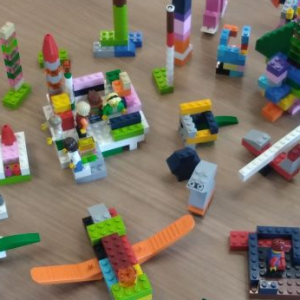
Moving Motivators
What do you do when you need to make a decision? How do you know what makes your new hire tick? How do you know what gets under your own skin?
One of the easiest and fun ways to delve into your intrinsic motivations is to play Moving Motivators! (created by Jurgen Appelo)
You can buy or download the cards from the link above.
The game is played in three steps.
Step 1: define which motivators are important to you.
Step 2: Discuss how change affects your motivators. Move the cards up for a positive change and down for a negative one and then look at whether you have more cards up or down. This is a great way to help make decisions.
Step 3: Time for reflection and discussion. Talk to your teammates about which motivators are least and most important to them. This will give you better insight into what drives your colleagues and allow you to create stronger relationships and increase collaboration.
